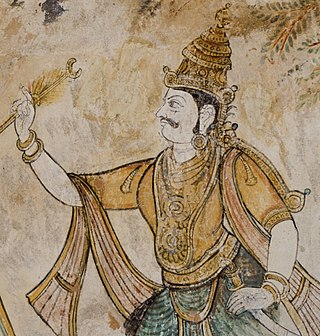
Rajaraja I, also known as Rajaraja the Great, was a Chola emperor who reigned from 985 CE to 1014 CE. He is known for his conquests of South India and parts of Sri Lanka, and increasing Chola influence across the Indian Ocean.

Kulottunga Chola I also spelt Kulothunga, born Rajendra Chalukya, was a Chola Emperor who reigned from 1070 to 1122 succeeding his cousin Athirajendra Chola. He also served as the Eastern Chalukya monarch from 1061 to 1118, succeeding his father Rajaraja Narendra. He is related to the Chola dynasty through his mother's side and the Eastern Chalukyas through his father's side. His mother, Ammangaidevi, was a Chola princess and the daughter of emperor Rajendra Chola I. His father was king Rajaraja Narendra of the Eastern Chalukya dynasty who was the nephew of Rajendra and maternal grandson of Rajaraja Chola I. According to historian Sailendra Nath Sen, his accession marked the beginning of a new era and ushered in a period of internal peace and benevolent administration. He was succeeded by his son Vikrama Chola

Rajendra I, often referred to as Rajendra the Great, Gangaikonda Cholan, and Kadaram Kondan, was a Chola Emperor who reigned from 1014 and 1044 CE. He was born in Thanjavur to Rajaraja I and his queen Vanavan Mahadevi and assumed royal power as co-regent with his father in 1012 until his father died in 1014, when Rajendra ascended to the Chola throne. During his reign, the Chola Empire reached its zenith in the Indian subcontinent; it extended its reach via trade and conquest across the Indian Ocean, making Rajendra one of only a few Indian monarchs who conquered territory beyond South Asia.
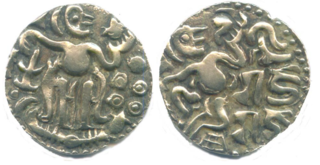
Rajadhiraja Chola I was a Chola emperor, as the successor of his father, Rajendra I. He was the only Chola emperor who was killed while leading his army in war, and although he had a short reign, he helped his father conquer several territories as well as to maintain the Chola authority over most of Sri Lanka, Eastern Chalukya and Kalinga, among others. He also established imperial relations with overseas allies despite a series of revolts in the territory.

The Chola dynasty was a Tamil dynasty originating from southern India. At its height, it ruled over the Chola Empire, an expansive maritime empire. The earliest datable references to the Chola are from inscriptions dated to the 3rd century BCE during the reign of Ashoka of the Maurya empire. The Chola empire was at its peak and achieved imperialism under the Medieval Cholas in the mid-9th century CE. As one of the Three Crowned Kings of Tamilakam, along with the Chera and Pandya, the dynasty continued to govern over varying territories until the 13th century CE.
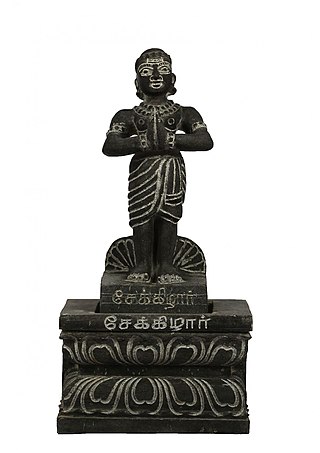
Sēkkilān Mādēvadigal Rāmadēva, known popularly by his family name as Sekkizhar, was a saint and a contemporary of Kulottunga Chola II. He compiled and wrote the Periya Puranam in 4253 verses, recounting the life stories of the sixty-three Shaiva Nayanars, the devotees of Shiva. Sekkilhar himself was later canonised and his work, the Periyapuranam became the twelfth and final book of the sacred Saiva canon.
Vengi or Venginadu is an Indian region in modern-day Andhra Pradesh spread over the Godavari and Krishna river deltas. The capital city of Vengi is located at Pedavegi near Eluru. Vengi was the most prominent city in Ancient Andhra for nearly seven centuries. Vengi served as the capital for Andhra dynasty like Salankayanas This region was part of Ashoka's Mauryan Empire in the mid-3rd century BCE. After the Mauryan Empire collapsed in 185 BC, the region was dominated by the Satavahanas, who were succeeded in Vengi by the Andhra Ikshvakus. Around 300 CE, the Andhra Ikshvakus were replaced by the Salankayanas. In the late 5th century, the Salankayanas were annexed by the Vishnukundinas.

Vikramaditya VI became the Western Chalukya King after deposing his elder brother Someshvara II, a political move he made by gaining the support of Chalukya vassals during the Chola invasion of Chalukya territory. Vikramaditya's reign is marked with the abolishment of the Saka era and the start of the Chalukya-Vikrama era. He was the greatest of the Western Chalukya kings and had the longest reign in the dynasty. He earned the title Permadideva and Tribhuvanamalla. He had several queens who ably assisted him in administration. One of his queens, Chandala Devi, a princess from the Shilahara ruling family of Karad was called Abhinava Saraswati for her skills as an artist. Queen Kethala Devi administered the Siruguppa region and Savala Devi was in charge of an Agrahara in Naregal. According to the historian Kamath, Vikramaditya VI was a "great king who ruled over South India" and he finds a "pride of place in Karnataka history". More inscriptions in Kannada are attributed to Vikramaditya VI than any other king prior to the Vijayanagara era.

Rajendra Chola II often referred to as Rajendradeva Chola was a Chola emperor who reigned from 1052 CE to 1064 CE. Rajendra II succeeded his brother Rajadhiraja I after his death at the Battle of Koppam. Rajendra had served as a Co-regent under his brother from 1044 CE to 1052 CE. When he acceded the throne, the Chola Empire was at its peak stretching from Southern India to Vengai(Bengal) to parts of Southeast Asia. Rajendra had maintained the territories of his predecessor. During his reign, the Chola Empire was prosperous and had a large influence in trade throughout the Indian Ocean.

Virarajendra Chola was a Chola emperor. Son of Rajendra I, he spent a major part of his life as a subordinate to two of his elder brothers, Rajadhiraja I and Rajendra II. During his early reign, he granted the maintenance of a school to study the Vedas, Sastras and grammar. A hostel was provided for the students. A hospital named Virasolan was also provided by him for the sick people. The famous Tamil Buddhist grammatical work, Virasoliyam, was written by Buddhamitra during his reign.
Athirajendra reigned for a very short period of few months as the Chola king succeeding his father Virarajendra. His reign was marked by civil unrest, possibly religious in nature. Athirajendra was last clan of Chola dynasty. He was killed in the religious chaos. Athirajindra and Virarajendra interfered in the Vengi succession disputes after the Vengi king Rajaraja Narendra, who was closely related to the Chola clan through his mother Kundavai, a daughter of Rajaraja Chola, died in 1061 CE. The Vengi throne went to Saktivarman II in a palace coup. The Cholas wanted the Chola influence re-established in Vengi. Saktivarman II was killed, but Vijayaditya, Saktivarman's father assumed the throne and repulsed the Chola attempts at unseating him. Vijayaditya however accepted to serving as a Chola vassal.

The Chola Empire, which is often referred to as the Imperial Cholas, was a medieval thalassocratic empire based in southern India that was ruled by the Chola dynasty, and comprised overseas dominions, protectorates and spheres of influence in southeast Asia.

Vikrama Chola, known as Kō Parakēsari Varman, was a 12th-century ruler of the Chola Empire in southern India. He succeeded his father Kulothunga I to the throne. Vikrama Chola was crowned as the heir-apparent by his father early in his life. He was appointed as viceroy of the Vengi province in 1089 C.E., succeeding his brother Rajaraja Chodaganga. Vikrama during his tenure successfully managed to check the ambitions of the Western Chalukya Vikramaditya VI on the Vengi kingdom.Vikrama Chola inherited the territories which included Tamil Nadu and some parts of Andhra Pradesh.

Rajaraja II was a Chola emperor who reigned from 1150 to 1173. He was made his heir apparent and Co-Regent in 1146 and so the inscriptions of Rajaraja II count his reign from 1146. Rajaraja's reign began to show signs of the coming end of the dynasty.
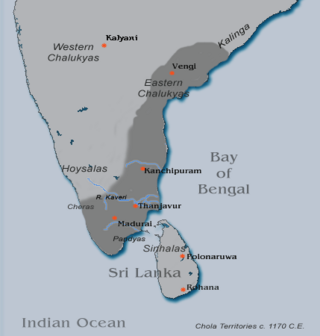
Rajadhiraja Chola II reigned as the Chola emperor succeeding Rajaraja Chola II. Rajaraja Chola II chose Rajadhiraja II, a maternal grandson of Vikrama Chola Because he had no sons. Rajadhiraja II's father was Sangama chola who was the descendant of Virarajendra chola. Hence a century later the real Chola heir ascended the chola throne.

Kulothunga III was a Chola emperor who ruled from 1178 to 1218 CE, after succeeding his elder brother Rajadhiraja II. Kulothunga Chola III gained success in war against his traditional foes. He gained victories in war against the Hoysalas, Pandyas of Madurai, Cheras of Venad, the Sinhalese kings of Polonnaruwa, as well as the Telugu Cholas of Velanadu and Nellore. He also restored Chola control over Karur, which were ruled by the Adigaman chiefs as vassals of the Cholas. He drove out the Hoysalas under Veera Ballala II who had made inroads in the Gangavadi and adjoining areas of Tagadur in Kongu country in an effort expand their territory. However, during the last two years of his reign, he lost in war to the resurgent Pandyas, heralded a period of steady decline and ultimately, demise of the Cholas by 1280 CE. Kulottunga III had alliances with the Hoysalas. The Hoysala king Veera Ballala married a Chola queen called Cholamahadevi and gave his daughter Somaladevi in marriage to Kulottunga III.
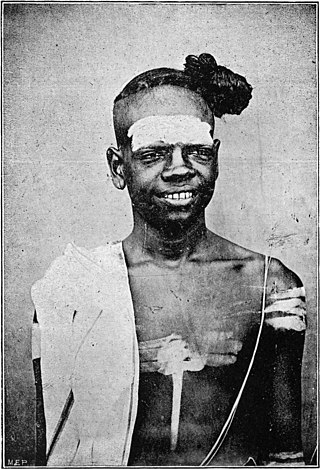
Dīkṣitars or Thillai Vazh Anthaanar are a Vedic Shaiva Brahmin servitor community of Tamil Nadu who are based mainly in the town of Chidambaram. Smartha, Sri Vaishnava and other Brahmins in South India also carry the surname Dikshitars, but are different from the Chidambaram Dishitar.

Ottakoothar was a Tamil court poet and minister to three Later Chola kings, namely Vikrama Chola, Kulotunga II and Rajaraja II. He wrote poems in praise of these three kings.

Karunakara Tondaiman was a general of Chola Emperor Kulottunga I. He is renowned for leading the Chola invasion of Kalinga during the reign of Kulottunga I and is the hero of Jayamkondar's poem Kalinkkattuparani In the Parani poem he is referred to as the lord of Vandai. while in the Draksharamam inscription of Kulottunga I, he is called as Vanduvaraja and Pallavaraja. He also served as a minister under Kulothunga Chola's son and successor, Vikrama Chola.
Naralokaviran, also known as Kalinga Rayan, was a general in the Chola army during the reign of Kulottunga I and his successor Vikrama Chola. He was the headman of Arumbakkam and a resident of Manavil in Manavil Nadu in Tondai Mandalam. He maintained a large fief at Manavil. Naralokaviran led many Chola campaigns in the deep south and distinguished himself in the Pandya Wars. He had many titles like Madurantaka Ponnambala-koothar, Sabharnataka, Kalinga Rayan, Porkoyil-Tondaiman, Koothan, Tondaiyarkon, the Lion of Kalinga.


















